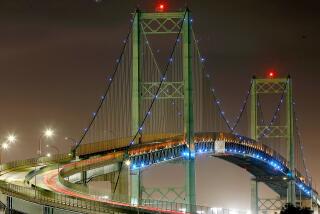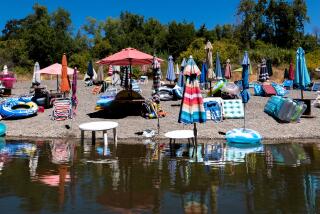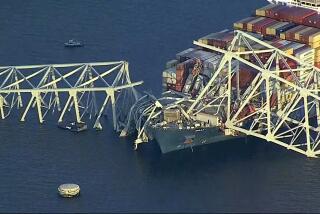‘Cassan’s Crossing’ : Oceanside Man Knows How to Bridge the Gaps
- Share via
Jack Cassan knows the San Luis Rey River like he knows the calluses on his hands. And he knew it was time to take action.
The river, a mere trickle during dry months, had filled to the brim as a series of torrential rainstorms passed over Oceanside during the winter of 1980. As the water rushed downstream to greet the ocean, it swept away the dirt causeway leading to Prince of Peace Abbey and to Cassan’s auto wrecking yard, which share the high ground on the northern bank of the river.
It was nothing new. The road across the river had been washed out at least half a dozen times in recent years, cutting the monastery and Cassan’s business off from the rest of the world for weeks at a time. Sure, there had been plenty of talk between landowners and city officials about building a permanent bridge, but the project was hung up on a sand bar of red tape.
‘Cassan’s Crossing’
So it was that Jack Cassan got a great notion. Let’s stop all the jawboning, he decided, and just do it.
Using his mind as a blueprint and friends as a work crew, Cassan set out to build his own bridge. To hell with city permits and engineering niceties. Within days, a series of oddly shaped, precast concrete pilings were sunk deep into the riverbed and more than a dozen junked railroad flatcars were set on top. A layer of asphalt was laid down as the roadbed.
It wasn’t pretty, but the 400-foot-long bridge worked. Dubbed “Cassan’s Crossing” by local wags, the structure has stood for six years, unscathed as the San Luis Rey roared down its serpentine course during recent winters.
Vintage Cassan
More than anything, the episode was vintage Cassan. The 61-year-old resident is known throughout Oceanside as one of the area’s most colorful characters, a dogged individualist who would much prefer to quietly get a job done instead of listening to bureaucrats flap their gums.
“Jack is salt of the earth,” said Mayor Larry Bagley, a longtime fan of Cassan. “He has a very basic philosophy of right and wrong. And he’s one of the fairest individuals I ever met.”
Indeed, many of Cassan’s friends say the man is downright altruistic. A confirmed car nut, Cassan collected $100,000 in 1985 when his 1914 Dodge finished first in the Great American Race, a coast-to-coast road rally for antique cars. To the disbelief of the race organizers, Cassan, who is not Catholic, donated every last penny to the monks at Prince of Peace Abbey.
“The interesting thing is that no one in town was really surprised,” Bagley said. “It was totally in character.”
Flood Nearly Ruined Tenant
On another occasion, a man leasing land near the river from Cassan for a truck salvage operation had his business all but ruined when a dike broke, allowing the river to flood the property. The businessman was on his last legs, pondering whether he should just chuck the whole thing and try another line of work.
Cassan decided that would be a shame. “I just told him, ‘Hell, don’t pay rent for the next year and get back on your feet,’ ” Cassan recalled. “He was so proud he was paying his rent in six months.”
A soft-spoken man, Cassan says such acts are simply the neighborly way to behave.
“They’re nice to me, too, you know,” he said. “It’s a two-way street.”
Cassan looks the part of a man with such tested, down-home values. His graying hair is cropped short and always seems to be tousled. Small eyes hide behind oval bifocals. The face is resolute, and never seems to show much expression.
His hands are big, shop-worn from hours of work on the cars that are both his profession and hobby. Most days, Cassan dons a faded flannel shirt, well-used work pants and leather construction boots. Put a sprig of straw in his mouth and Cassan would look like just another country bumpkin.
‘Rugged Individualist’
This, however, is a canny and successful businessman. Over the decades, Cassan has put together a profitable auto salvage outfit, which he now leases to other operators. He also has amassed more than 30 acres of property along the San Luis Rey, with a price tag well into the millions.
“He comes across as a good old country boy, but he’s effective,” said Councilman Lucy Chavez, a lifelong Oceanside resident who has known Cassan since he was a youth. “He’s a rugged individualist, a man with a mind of his own. When he sees a job to be done, he goes out and gets it done.”
Though Cassan has had his share of run-ins with the City Hall Establishment, he has earned the respect of many officials. Indeed, in recent years, Cassan has become part of the bureaucracy. Last year, Bagley named Cassan a planning commissioner.
Since then, Cassan has become a common sight at City Hall, pulling up for meetings in his battered, 20-year-old pickup (which he recently replaced with a new model) and dishing out votes that are decidedly pro-business and pro-growth.
His philosophy is simple: If a person owns a piece of property, they should be allowed to do what they want as long as it doesn’t hurt someone else. Understandably, that sort of logic has earned him plaudits from businessmen and developers, while environmentalists and slow-growth advocates typically consider Cassan an enemy.
In Oceanside 62 Years
Born John Francis Cassan Jr. in 1925, he came to Oceanside with his parents as a toddler after his father lost his job as a stockbroker at the start of the Depression.
Even when he was still just riding a bicycle, Cassan got a reputation as an expert mechanic, someone who could strip an engine and put it back together again blindfolded. Book learning, however, didn’t come so easily, what with so many cars to work on.
At 17 he entered the Navy. Toward the end of World War II, he was on the aircraft carrier Yorktown in the South Pacific, working on airplanes that fought some of the final battles of the war.
Back stateside, he tried college and again found there were just too many diversions. “I was working on jukeboxes, collecting money, and was becoming a drunk because all you do is go from bar to bar,” he said.
Eager for a change, Cassan got a job as a commercial tuna fisherman in 1948. After five years of serving on ships as a mechanic, he decided he had had enough of the long, tedious trips to sea and decided to go into business.
Early Years Tough
Borrowing money from friends and family, Cassan leased an auto wrecking yard in Oceanside for $6,500 in 1953. It wasn’t much of a start, Cassan recalls: “I got 100 scrapped cars that were almost stripped, an old, broken-down tow truck, a flatbed truck in about the same condition, and some tools.”
The early years were tough. At times, Cassan would have to pay his employees with money his new wife, Millie, got from her job at the phone company. But he kept plowing money back into the business, eventually buying the land for his current operation along the San Luis Rey River.
Though Cassan is supposed to be semi-retired now, he still keeps his hand in the business. Most days he spends down at the wrecking yard operating a massive, motorized contraption that slams a 10-ton steel door down on cars, crushing them into waffle-thin plates of steel.
He and his wife built a rambling, tile-roofed home atop a flat, grassy mesa that commands views of the Pacific Ocean to the west and the wrecking yard to the east, its rows of junked automobiles glistening in the sun. His antique autos, among them a 1940 Lincoln Continental and the old Dodge, are mostly stored down at the wrecking yard.
The home was built on land owned by the abbey. Under an arrangement with the brothers, Cassan built the house and will donate it to the monks after he and Millie die. The couple have no children.
Though unique, the arrangement typifies Cassan’s relationship with the abbey.
Good Neighbor to Monks
Abbot Claude Ehringer recalls that, when Cassan first approached the city about moving his auto salvage operation next to the monastery in the early 1960s, many of the Benedictine brothers were alarmed.
“We didn’t want to have a wrecking yard in our front yard,” Ehringer recalled.
But after listening to Cassan, the brothers began to believe that the wrecking yard could prove a good neighbor. And Cassan has been just that, according to Ehringer.
“We all became close to him,” the abbot said. “It’s just been an ongoing, wonderful relationship. He’s done so much more for us than just the donation from his race winnings.”
Cassan has spent countless hours on his bulldozer and other earth-moving equipment to grade the ground beneath the monks’ nearly finished chapel, according to Ehringer. He also has personally maintained the abbey’s fleet of vehicles, even donating a large truck on one occasion.
But it is the bridge, perhaps more than any other thing, that has endeared Cassan to the brothers at the abbey.
When the San Luis Rey would begin to run, the monks were essentially bereft of a means of getting out of their community to run errands or gather supplies.
For a time, the brothers were allowed to use Camp Pendleton to the north as an access way during the rainy season, but that arrangement proved tedious and, ultimately, was discontinued when residents of a base housing project complained about the traffic past their homes.
River Became Barrier
The river posed an equally pressing problem for the wrecking yard. Sometimes, the water would be shallow enough to allow employees to ferry customers across in a Jeep. At other times, the currents were just too swift and no one could get over. They tried building a footbridge across using wooden pallets, but the thing had washed out within a few days.
“When I bought the land, the river had no water in it and hadn’t run for 20 years,” Cassan recalls. “I was dumb enough to think it would never run.”
Like other landowners in the area, Cassan was interested in forming an assessment district to finance construction of a bridge. But the project always seemed to be tied up by bureaucratic snafus.
“I finally just decided it was never going to happen,” Cassan said.
Though local lore has it that Cassan designed the bridge on the back of a paper place mat in a restaurant, he never actually drew up plans for the project during construction. Instead, the effort took on something of a life of its own.
First, Cassan heard about some railroad flatcars for sale by a government surplus operation up in Vallejo. He purchased them for $2,000, then persuaded a junk dealer to ship them down for free in exchange for the wheels on each flatcar.
He picked up the concrete pilings from a San Diego firm that was going out of business. A friend in the concrete business cut the pilings for free. Several buddies in the construction industry helped with the work, which was conducted under strict secrecy since no building permits had been obtained from the city.
In all, Cassan figures his private bridge cost about $150,000--a fraction of what is typically spent on such spans. For example, the Murray Toll Bridge on the San Luis Rey cost more than $5 million.
“His idea was very novel,” said Alton Ruden, a former Oceanside city engineer and lifelong friend of Cassan. “He asked me what I thought about it and I said it was beautiful. Those pilings are every bit as good as any other bridge on the river. It looks kind of strange, but that is a stout bridge.”
After 11 days of work, the bridge was nearing completion. Then a reporter from a local newspaper spotted the structure. When city officials learned about it, they shut down work on the bridge.
For the next three months, Cassan labored to prove to city officials that the bridge was up to the required specifications. After some minor alterations, the project was ultimately allowed to go forward.
But state Fish and Game Department officials were less than pleased and took Cassan to court, noting that the work had stripped the river of vegetation that serves as nesting habitat for birds. Ultimately, however, a Vista Superior Court judge sided with Cassan, and all charges were dismissed.
“It was obvious he hadn’t harmed the environment,” Ruden said. “The river’s still there. The willows and tules are still there. The work on the bridge temporarily mussed it up, but within six months you couldn’t tell anyone had been in there.”
Today, Cassan stands next to his bridge and looks up at the gangly span with pride.
“I figure,” he says, “this thing will outlast me.”
More to Read
Sign up for Essential California
The most important California stories and recommendations in your inbox every morning.
You may occasionally receive promotional content from the Los Angeles Times.










